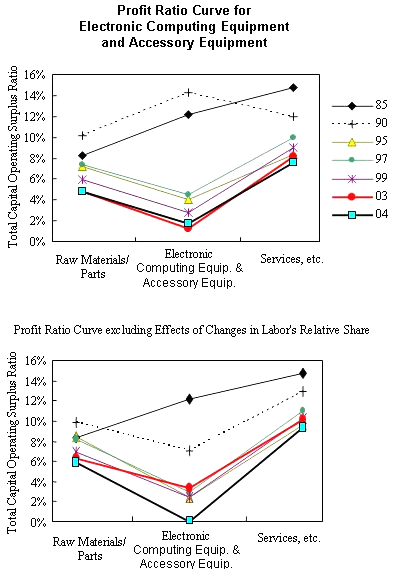The Continuing Smile Curve Phenomenon in Electronic Computing Equipment and Accessory Equipment: Further Validation for the Smile Curve
July 25 (Tuesday) 2006
Tatsuya Kimura
Research Fellow
SUMMARY
- The "Smile Curve" hypothesis has been advocated since the latter half of the 1990s, and in the 2000s the scope of the hypothesis has grown. The smile curve hypothesis describes a phenomenon in the assembly-type manufacturing industry, in which the progression of global competition has caused the ratio of value added or profit ratios within the value chain to decline-where previously levels had been high-while both ends of the value chain, i.e. raw materials and parts on one side and services, etc. on the other, have increased. (Hereafter, this mechanism is referred to as the smile curve hypothesis.)
Further Validation for the Smile Curve Phenomenon
There has been very little empirical research conducted on the smile curve phenomenon. In response to this, Kimura (2003) presented an empirical study of the value chain for the assembly-type manufacturing industry as a whole and six sectors therein (see note 1 below) using data up until 1999 (for the years 1985, 1990, 1995, 1997, 1999; see note 2) below) to calculate profit ratios. Following this study, however, various changes occurred in the conditions surrounding the assembly-type manufacturing industry, including the further development of modularization of core parts, the further development of China and other Asian countries and changes in the wage system. These changes have greatly affected the value chain in Japan, in which the assembly-type manufacturing industry forms the center. In order to reflect the changes that have occurred after the term dealt with in Kimura (2003), Kimura (2006) reexamines the smile curve phenomenon with information up until 2004 (see note 3 below). This paper focuses on the electronic computing equipment and accessory equipment, which shows representative results in the empirical study of Kimura (2006).
2004 Profits for Electronic Computing Equipment and Accessory Equipment Achieved via the Shrinking of Labor's Relative Share
According to the previous validating results using data up until 1999, the smile curve phenomenon examined by the profit ratio curve-extending from the beginning to the end of the value chain-was not clearly observed in the assembly-type manufacturing industry as a whole, but rather in three sectors, including the electronic computing equipment and accessory equipment sector. However, after excluding the decrease in profits resulting from the increase in labor's relative share after the latter half of the 1990s, the smile curve phenomenon examined by the profit ratio curve was only seen in the electronic computing equipment and accessory equipment sector. It is therefore clear that the smile curve hypothesis was observed only in the electronic computing equipment and accessory equipment sector.
According to the data up until 2004, the smile curve phenomenon in 2004 profit ratio curves was observed in the assembly-type manufacturing industry as a whole, and by industry sector it was observed exclusively in the electronic computing equipment and accessory equipment sector. However, after excluding the decrease in profits resulting from the increase in labor's relative share, the smile curve phenomenon was not observed in the assembly-type manufacturing industry as a whole, whereas it progressed greatly in the electronic computing equipment and accessory equipment sector between the years 2003 and 2004. The profit ratio for this sector was 0.0% in 2004. This shows that the shrinking of labor's relative share in the electronic computing equipment and accessory equipment sector in 2004 resulted in marginally positive domestic production profits.

Sources: Ministry of Finance, Ministry of Finance Policy Research Institute, "Ministry of Finance Statistics Monthly"; Management and Coordination Agency, "1985-1990-1995 Linked Input-Output Tables"; Research and Statistics Department, Economic and Industry Policy Bureau, METI, "1997 Input-Output Tables", "1999 Input-Output Tables"; METI, "The Updated Input-Output Table 2003 (Quick Estimation", "The Updated Input-Output Table 2004 (Quick Estimation)".
Note: Years displayed are in calendar years.
Concerns about the Continuation of Domestic Production
Factor decomposition was performed on the change in profit ratio in order to more clearly analyze the changes in the profit ratio that occurred from 2003 to 2004. The results verified that the factor responsible for boosting profit ratios in the electronic computing equipment and accessory equipment sector from 2003 to 2004 was the decrease of labor's relative share. On the other hand, the primary factor responsible for reducing profit ratios was confirmed as the increase in depreciation costs that occurred alongside the growth of investment in facilities, as well as the increase of consumption expenditure outside households (i.e. welfare expenses like lodging and allowances for business trips, entertainment expenses, medical fees, etc.)-also known as corporate consumption. The impact of these reduction factors on profit ratios was almost entirely cancelled out by the boosting factor of the decrease in labor's relative share (up 3.8% in 2004 from the year before).
The current expansion of the Japanese economy seems poised to become the longest of the post-war period. With this in mind, when we consider the tightening labor market and the growing desire for labor resulting from the mass retirement of the baby boomer generation, it is highly likely that labor's relative share will rise in the electronic computing equipment and accessory equipment sector as well. Thus, the reduction of depreciation costs, consumption expenditure outside households and other factors that could cancel out the effects of the increase in labor's relative share is crucial in order to make profits from domestic production in the electronic computing equipment and accessory equipment sector.
Notes
- Household electronic appliances, household electric appliances, electronic computing equipment and accessory equipment, communications equipment, passenger motor cars, trucks, buses, and other cars.
- Kimura, Tatsuya. 2003. “Waga kuni no kakou kumitate-gata seizougyou ni okeru sumairu kaabu-ka genshou: kenshou to taiou (The Smile Curve Phenomenon in the Japanese Assembly-type Manufacturing Industry)”. FRI ERC Research Report No. 167.
- Kimura, Tatsuya. 2006. “Waga kuni no kakou kumitate-gata seizougyou ni okeru sumairu kaabu-ka no saikensho (Further Validation for the “Smile Curve” Phenomenon in the Japanese Assembly-type Manufacturing Industry)”. FRI ERC Research Report No. 261.
